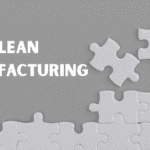
Spis treści
Lean MFG Tools: Essential Tools for Manufacturing Efficiency
In pursuing operational excellence, Lean Manufacturing (Lean MFG) provides a robust framework for reducing waste, improving quality, and increasing productivity. At the heart of this are the practical tools known as Lean MFG tools. These tools help organisations identify inefficiencies, streamline processes, and deliver greater value to customers.
Many of these lean tools and principles come from the Toyota Production System, which has set the standard for process improvement in the manufacturing industry. Lean MFG tools have transformed the manufacturing industry and are now used by manufacturing companies to boost efficiency and reduce losses.
Whether starting your lean journey or refining an existing implementation, understanding and applying the most impactful manufacturing lean tools is key.
What are Lean MFG Tools?
Lean MFG, or lean manufacturing tools, are structured methods and techniques for implementing lean manufacturing principles. They support the core goals of Lean: eliminating waste, increasing flow, improving quality, and delivering value to customers with minimal resources.
Each lean manufacturing tool is based on core lean manufacturing principles and the lean process improvement method, focusing on continuous improvement, waste reduction, and operational efficiency.
These tools are practical, actionable, and applicable across industries—from automotive plants to healthcare operations.
🔧 Looking to apply these tools in your factory or office? Our Lean Management course offers practical guidance based on over 25 years of experience.
Key Principles of Lean Management
At the heart of lean manufacturing are guiding principles that shape every improvement initiative. Lean management is a systematic approach to minimising waste and maximising value throughout manufacturing. Organisations can streamline their production processes and deliver higher-quality products with fewer resources by focusing on what truly matters to customers.
The key principles of lean management are:
- Continuous improvement: Encouraging ongoing, incremental changes to every aspect of the production process.
- Eliminate waste: Identifying and removing non-value-added activities that don’t add to customer value.
- Respect for people: Empowering employees at all levels to participate in problem-solving and process improvement.
Lean management is not just about applying lean manufacturing tools—it’s about creating a culture where everyone is committed to continuous improvement and eliminating waste. This mindset means every team member is engaged in making the manufacturing process more efficient, responsive, and aligned with customer needs.
Top Lean Manufacturing Tools

Here are the most widely used and practical lean manufacturing tools. These are some of the most common tools, but other lean tools, such as just-in-time manufacturing, also play a critical role in lean systems.
1. 5S (Sort, Set in order, Shine, Standardize, Sustain)
A workplace organisation method that eliminates clutter and ensures everything is in its place.
🎓 Want to master 5S? Try our 5S course.
2. Value Stream Mapping (VSM)
Value Stream Mapping is a visual tool that maps the entire process from raw materials to finished product so that organisations can see every step involved in production. It helps organisations analyse their current processes to identify waste, inefficiencies, and opportunities for improvement.
3. Kanban
Kanban is a visual management tool that supports just-in-time production. It enables a pull system, so resources and tasks are only mobilised when needed to maintain a smooth workflow. By aligning production to actual demand, Kanban creates more efficient processes.
4. Kaizen (Continuous Improvement)
A culture of minor, incremental improvements led by employees. Kaizen initiatives eliminate waste and drive waste reduction throughout the organisation. Encourages teams to suggest regularly and test process changes. The ultimate goal of Kaizen is efficiency at every level.
5. Poka-Yoke (Error Proofing)
Poka-Yoke systems are designed to prevent human error during manufacturing processes. By reducing mistakes, Poka-Yoke directly contributes to higher production quality, greater consistency, and fewer defects in assembly and quality control.
6. Andon
A visual feedback system (often a light or screen) that alerts team members or supervisors to issues in real-time.
7. Standardised Work
A single best method for a task, which improves consistency and efficiency across shifts or teams.
8. A3 Problem Solving
A3 is a problem-solving methodology that provides a structured approach to root cause analysis and solution implementation. It focuses on identifying and addressing root causes of issues, not just symptoms. The process is laid out on a single A3-sized sheet for clarity and focus.
🧠 Improve your problem-solving skills with our Problem Solving course.
9. Takt Time
Takt Time is calculated based on customer demand and sets the production pace to meet these requirements. Helps to balance workloads and reduce overproduction.
10. Gemba Walks
Management walks to see operations firsthand, listens to employees, and identifies areas for improvement.
Measuring Efficiency: Equipment Effectiveness
Understanding how well your equipment performs is critical to optimizing production processes in lean manufacturing. Equipment effectiveness measures the ability of machinery and equipment to produce quality products efficiently and reliably.
A key metric used in this context is Overall Equipment Effectiveness (OEE). OEE measures equipment performance by considering three key factors:
- Availability: The percentage of scheduled time the equipment is available to run.
- Performance: How fast the equipment runs compared to its maximum speed.
- Quality: The proportion of good units produced versus total units started.
OEE is calculated by multiplying these three rates, which gives a complete view of equipment effectiveness. By tracking overall equipment effectiveness (OEE), manufacturers can identify downtime, slow cycles, or defects that impact productivity. This insight is key to continuous improvement and ensuring production runs at peak efficiency.
Performance Metrics: Key Performance Indicators
Progress must be measured with clear, actionable metrics to achieve operational excellence in lean manufacturing. Key Performance Indicators (KPIs) help organisations measure the effectiveness of their manufacturing processes and overall performance.
Common KPIs in lean manufacturing are:
- Lead time: The total time to produce and deliver a product.
- Throughput: The number of units produced in a given time.
- Defect rate: The percentage of products that don’t meet quality standards.
These KPIs give valuable insight into where to improve and track the impact of lean manufacturing tools and initiatives. Aligning KPIs with the organisation’s strategic goals ensures that every improvement effort supports the overall business objectives and drives sustained manufacturing performance and customer satisfaction.
Strategic Planning: Hoshin Kanri
Long-term success with lean management requires more than daily improvements—it needs a clear strategic direction. Hoshin Kanri is a strategic management approach that aligns an organisation’s goals and objectives with its vision and mission.
The Hoshin Kanri process involves a structured 7-step planning process:
- Set the organisational vision.
- Develop breakthrough objectives.
- Set annual objectives.
- Deploy objectives throughout the organization.
- Execute plans.
- Review progress.
- Adjust as needed.
By using Hoshin Kanri, organisations ensure that every improvement project and lean initiative is focused on achieving strategic, breakthrough objectives. This approach aligns top management and front-line teams, making lean management a driver of daily process improvement and long-term business growth.
Implementing Continuous Flow
Implementing a continuous flow approach is one of the most effective ways to enhance production efficiency in lean manufacturing. This principle ensures that products move smoothly through each stage of the production process, with no interruptions and no bottlenecks.
To achieve continuous flow, organisations must:
- Identify and remove obstacles that stop the production process.
- Focus on process improvement to ensure a smooth flow of materials and information.
- Remove waste such as inventory, waiting time, and unnecessary movement.
The benefits of continuous flow are substantial: reduced lead times, improved quality, and increased efficiency throughout the production line. By implementing continuous flow, manufacturers can respond faster to customer demand, reduce costs, and create a more agile operation.
Lean Production Tools: Benefits and Outcomes
Using lean production tools gives:
- Streamlined processes
- Less downtime and waste
- More employee involvement
- Better alignment to customer demand
- Improved safety and cleanliness
- Measurable cost savings
- Increased operational efficiency and the ability to improve continuously
Lean production tools are designed to improve efficiency across all areas of manufacturing.
📈 Learn how to achieve these outcomes step by step in our Lean Management course.
Lean Tools in Different Industries
While most commonly associated with manufacturing, lean tools can also be applied in:
- Logistics and warehousing
- Healthcare (e.g., patient flow improvements)
- IT (e.g., Lean Agile frameworks)
- Construction and field services
- Finance and administration
Total Quality Management (TQM) and Total Productive Maintenance (TPM) are also used in various sectors. Total Productive Maintenance (TPM) is a comprehensive, proactive approach to equipment maintenance that maximizes operational efficiency and minimizes downtime.
Each industry adapts these tools to its process challenges, resource constraints, and customer requirements.
Choosing the Right Tools for Your Organisation
Not every tool fits every situation. Consider the following when selecting manufacturing lean tools:
- Current process maturity* Employee capability
- Data availability
- Organisational culture
- Bottleneck analysis or single-minute exchange of dies
Start with a few suitable tools and grow from there. It’s often best to test new tools on a small scale before implementing them fully.
🎓 Not sure which tools to start with? Our Lean Management course helps you choose, apply, and adapt lean tools to your situation.
Building a Lean Culture
A lean implementation isn’t just about tools – it’s about mindset. Embedding lean thinking across the organisation means:
- Everyone looks for waste
- Employees contribute ideas
- Leaders support experimentation
🧩 See how team dynamics impact lean success in our Teamwork and Leadership course.
Beyond the Basics: Improvement
Once the core lean manufacturing tools are in place, the next step is to sustain the gains and look for further improvements. This is where a continuous improvement program comes in.
It ensures lean isn’t a one-off project but an ongoing journey.
Please learn how to build a long-term lean improvement framework in our Continuous Improvement course.
🎓 Ready to Use Lean MFG Tools Like a Pro?
If you want to move beyond theory and apply lean production tools in your business, our Lean Management course is the place to start. With templates, checklists, and real-world examples, it gives you everything you need to drive efficiency and performance.
🎥 You can even try a lesson for free.
🎮 Looking for a more interactive learning experience? Try our GET LEAN Simulation Game—a fun way to test your skills and reinforce lean knowledge.


